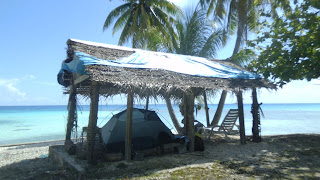Sailing through the South Pacific archipelagos
As
an adolescent I gave myself a hard time at school in the early 70ies.
However, I do remember the double sided map in my geography atlas of
the vast south pacific and its atolls - harbouring my imaginations in
its unique circle of coral reefs, sandy stripes and coconut
palmtrees. I also recall the unfamous part of nuclear tests at the
Mururoa atoll. It took the paintings of Paul Gauguin to keep my
positive interest on those remote groups of archipelagos somewhere
lost in the south sea.
Well,
what do you know about or associate with an atoll?
So
I bought a triangle ticket with Air Tahiti to the Tuamotu archipelago
to find out in person what an atoll is all about: some kind of island
that eventually is a lagoon, surrounded by coral reefs and sporadic
elevations of white sand and palm trees, some of them inhabited, long
before the first European navigators like Magelan or Cook
"discovered" them. Like Tikehau - its lagoon measuring more
than 20 km in diameter, and counting about 400 people in the only
village!
Oh,
don't forget ... time still has a different dimenson in the South
Pacific. That does not mean my plane did not depart on time. Upon
arrival at Tikehau, I asked a local person for a place called "Chez
Justine". "Oh, Madmoiselle Justine, she's right there at
the airfield, attending the passengers to board the plane".
Well, in a village that ends half way along the runway, people assume
more than one function. Paciently I was waiting in the small open
arrival and departure hall till she closed the airport - about 20
minutes after the plane went on to the next atoll: Rangiroa, my next
destination.
Eventually
her parents' place was just around the corner. No worries - her
father directed me straight to "my" camp place ... and
indeed, now I know what is an atoll. Awesome, incredible! I placed my
tent on the edge of the inner beach, overlooking the magic circle
surrounding the blue lagoon.
What
else one should know about an atoll? Maybe I should share some basic
rules and first experiences for a first-time-visitor-to-an-atoll: Do
not place your tent in the promising shadow of a coconut tree. I
guess you can imagine why a coconut following the law of gravity
always wins. Don't bet on your head!
Good
news: there are no crocodiles, nor snakes. However, while I placed my
tent right at the beach, I saw some black fins moving up and down the
lagoon, not further than 5 meters from my place. "No worries"
my host explained, "these sharks don't bite". Would you
believe the advise of a local? By nature, I am still not convinced,
as they show up in groups of five to six, reminding me the street
dogs in Beira, fletching their teeth when they "take over"
the city during night.
A
morning hike on the only inhabited island around the lagoon - what
basically means walking once around the airfield - takes at least two
hours, greeting all of the 163 friendly people along the only road.
Indeed, this figure stands for the 397 islanders, minus the kids and
teacher attending classes. Oh yes, sorry - I forgot to count the two
guys diving in the lagoon for black pearls. Midday - tomorrow - they
say, the weekly cargo vessel will arrive. Great, because both small
shops ran out of onions, an essential part of my daily cooking: fried
noodles with ham, cheese, egg ... and onions.
I
guess that is enough for a first introduction about an atoll. Soon I
will move on: Rangiroa, the biggest atoll in the Tuamotu archipelago.
To be more precise: big stands for the expansion of the lagoon -
stretching about 75 km in length, and 25 km wide. Probably one can't
count the sharks in it. But at least I can't miss my plane, with the
airfield just behind my tent and Mademoiselle Justine having the keys
; )







Comments
Post a Comment